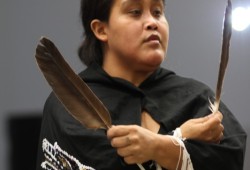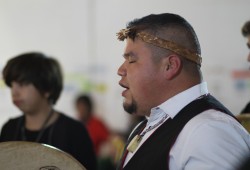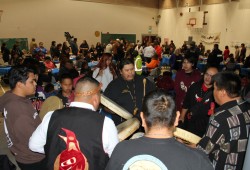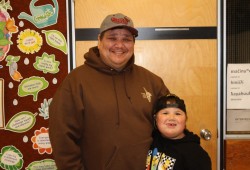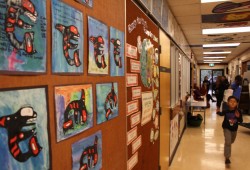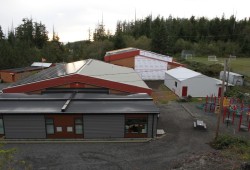Since the Maa-nulth Final Agreement came into effect over a decade ago, a hole has existed right in the middle of the Ka:'yu:'k't'h'/Che:k'tles7et'h' First Nations treaty settlement land. Amid an ongoing housing shortage in its village on the northwest coast of Vancouver Island - with pressing needs for infrastructural upgrades - the 40 acres that remained under the ownership of the region’s school district lingered over the years as a barrier to the First Nation gaining the full self-determination that it had fought decades for leading up the Maa-nulth treaty.
But this is now set to change, with an agreement for School District 84 to transfer ownership of the land to Ka:'yu:'k't'h'/Che:k'tles7et'h'. After the First Nation gains authority over the property SD84 will continue to run the Kyuquot Elementary Secondary School, according to a memorandum of understanding signed between the school district and Ka:'yu:'k't'h'/Che:k'tles7et'h' on Oct. 24.
Taking care of the “donut hole in treaty land” is an important addition for the First Nation in how it develops its main village of Houpsitas, according to Jeff Nielson, Ka:'yu:'k't'h'/Che:k'tles7et'h'’s director of Lands and Resources.
“I think the attitudes [of] both the school district and the ministries responsible for ownership of land have changed,” he said, reflecting on how things have developed since the treaty came into effect in 2011.
Years after the treaty was implemented, Dean Johnson, SD 84’s director of Instruction, Operations and Technology, approached the First Nation about the school property.
“I remember pulling out the map and thinking, ‘Oh my goodness, there’s this big chunk of land that the nation doesn’t even own. How can they develop and build around it?’,” said Johnson. “This didn’t sit right with me.”
“The school district still has effective ownership of the school property, but they’re only using a quarter of the property,” explained Nielson. “It means that the nations can use the rest of the property, and that’s fully accessible to the nations.”
The ownership transfer comes at no cost to the First Nation, and as SD84 continues to run the school provincial funding for maintenance and expanding the facility will still be available.
The ownership transition was announced in the school’s newly renovated gymnasium. When the community celebrated the signing of the agreement the paint was barely dry in the newly expanded gym, which grew from half to full size over the summer months.
At the Oct. 24 event Johnson expressed hope that ownership transition will lead to improved maintenance of the remote community’s school.
“When I became the facilities director, I came up to the school and saw that it wasn’t up to standard,” he said. “It wasn’t because of anything about the nation or even anything about the school district; it’s a hard place to maintain facilities. Crews would come up and try and work on things, but they didn’t always have the right materials, and over a period of years the school began to be quite run down.”
“It’s been a great joy of mine to see the school being rebuilt and renovated,” said Johnson.
Ka:'yu:'k't'h'/Che:k'tles7et'h' is in the middle of planning how the acquired land will be developed, said Nielson. He expects that the full ownership transition will be completed next year, making the school district property treaty settlement land.
“When that happens we’ll be able to determine what goes where and will be subject to Strathcona Regional District bylaws," noted Nielson. “The only road out of the village goes through this property, so it is the logical place where you would start to build more when you have the ability to do that.”
First graduating class in 1998
As a youth Ka:'yu:'k't'h'/Che:k'tles7et'h' member Kevin Jules moved to Houpsitas to attend the KESS for his high school years. He moved in with his grandmother, the late Patricia Nicolaye, who had converted a small kitchen in her house to make another bedroom.
“Three bedrooms, and we had 13 of us living in there. It was a tiny little old house,” recalled Jules. “My mother passed away in 1999, so that was when we all moved in with my grandmother, she took us all in. There was a lot of us in the house, but she got us up every day for breakfast, got us out. She’s the one who got us up every morning, got us motivated to go to school, telling us how important it was.”
Jules graduated from KESS in 2000, the third Grade 12 group since the school began including the senior grades in 1998. Before then teenagers had to move away from the community to continue their high school studies, staying in Campbell River or elsewhere with any family who could house them.
“That took a lot from our community,” said Jules, who serves as a legislative member for the First Nation. “We still have people who moved away for their children’s education, who can’t come back because of our lack of infrastructure. We can’t build any more houses at the moment. The capacity of our electricity outloads, we can’t add to it.”
Jules worked at KESS as an education assistant after graduating, but in the years since he has been unable to return to the Ka:'yu:'k't'h'/Che:k'tles7et'h' village due to the lack of infrastructure for housing.
“I’ve been wanting a house here for a long time, I had to move due to a lack of housing,” he said, hoping that the necessary electrical and sewage services can be improved to finally bring more homes to Houpsitas. “Maybe one day I can bring my son and he can go to school here.”
Awakening to opportunities
Since 1998 graduating classes have ranged from the nine that Jules was a part of to just one student in some years. For a community with no roads connecting it to the rest of Vancouver Island, where the closest city is a 40-minute boat ride followed by a three-and-a-half-hour drive (partly on a logging road) to Campbell River, formal education has not always been a top priority.
But recent results indicate that this could be changing. Six of the seven KESS graduates from the last school year are now in post secondary, attending institutions such as North Island College, Vancouver Island University and the University of British Columbia. This took a lot of coaching and individual attention over the students’ final year of high school, said KESS Principal Natalie Dickson.
“I came in to not a lot of success at that high level, so there was a lot of non-grads,” said Dickson, who started at KESS for the 2022-23 school year. “What you do is the really authentic work on career planning. Our job is to take away barriers.”
This includes visiting campuses with students to help them prepare for the transition.
“With our student that went to UBC Okanagan, in June we drove up there to do an orientation so we know what that’s going to look like, what that’s going to feel like,” said Dickson.
The First Nation even paid for one of its university students to travel back to Houpsitas for the Ka:'yu:'k't'h'/Che:k'tles7et'h' people’s assembly on Oct. 23 and 24, where formal education was discussed among top priorities.
But this hasn’t always been the case, said Jules.
“When you’re out here in an isolated community, you get through with your education, then you just go on with life,” he said. “People are starting to realize that there’s more opportunities out there, especially within our nation. Our office is growing so fast, and there so many jobs there that are available, but we need people who are properly educated.”
Community involvement is critical
Like many schools in remote communities, in the past retaining good teachers has been a challenge for the small school. Partway through the 2019-2020 year, two of the school’s five teachers left. Then in February 2020 a parents advisory committee was formed in the hopes of better engaging with parents to support their children in school.
The following November the community faced the unfortunate dilemma of a teacher who was reportedly verbally abusive to students and showing up to class in a drunken state. He was suspended after his in-class ramblings were secretly recorded by a student, who hid a cell phone under a binder, according to a Ha-Shilth-Sa article from the time.
But Dickson saw opportunity when she arrived in 2022, and started her term as principal with an entirely new roster of teachers. Now seven serve the 44-students, providing one-on-one attention that most small community schools could only dream of. Despite the remote location, Dickson was able to “hand pick” educators who were right for Kyuquot.
“It’s about shared beliefs and values,” she said. “What I’m able to do is select people that want to kayak after school, that want to be connected on the land.”
The school district is also funding the training of six local people to serve in the roles of education assistants and human services, bringing the necessary community interaction into the day-to-day education offered at KESS.
“They bring learning opportunities to us; I don’t need to ask them,” said Dickson of the role that Kyuquot and the First Nation takes in the school. “That connection to language and culture grounds students for success.”
For the next several years SD84 will run the school, but the property transfer comes with a hope that Ka:'yu:'k't'h'/Che:k'tles7et'h' will gain more influence on the curriculum, eventually taking over operations at KESS.
“The majority of the students here are KCFN, so we do want to eventually be able to run the school. We want to phase in,” said Cynthia Blackstone, Ka:'yu:'k't'h'/Che:k'tles7et'h'’s chief administrative officer.
Blackstone pointed to the value of the First Nation’s Warriors youth program as an example of how the curriculum could eventually be changed. The Warriors recently built a cabin nearby on Spring Island, but although this project drew upon several teachings from the classroom, it wasn’t recognized for high school credit.
“They had to consider archaeology, they had to consider all the math in it, they had to consider the logistics of getting all the materials out there, they had to consider all the weather conditions,” said Blackstone. “You couldn’t actually teach someone about it without actually putting them through it. It’s those sorts of projects that build the life skills that I think we can provide in the school versus just classroom time.”
Over recent years the First Nation’s ancestral language has been increasingly incorporated into the school, and now panels can be found in the hallways that play a Nuu-chah-nulth word when touched.
“It brings back a lot of pride to our people,” said Jules of the First Nation’s content in the school. “When I went to school here we had First Nations and French. We had to either pick which one we wanted to do. Now it’s opened up the doors to learning more of our own history, our own language.”
One of the recent grads from last year has started working with a language mentor from the community, studying with the elder via video link as she attends UBC. She’s trying to eventually become fluent in the language of her ancestors, said Dickson.
“I think it’s a big goal in Kyuquot that we all work together to help everyone,” she noted. “I love how excited Kyuquot is for the future. I’ve never seen a community so ready to be heard, and ready to take huge steps into what’s next. That is extremely exciting to be part of.”


